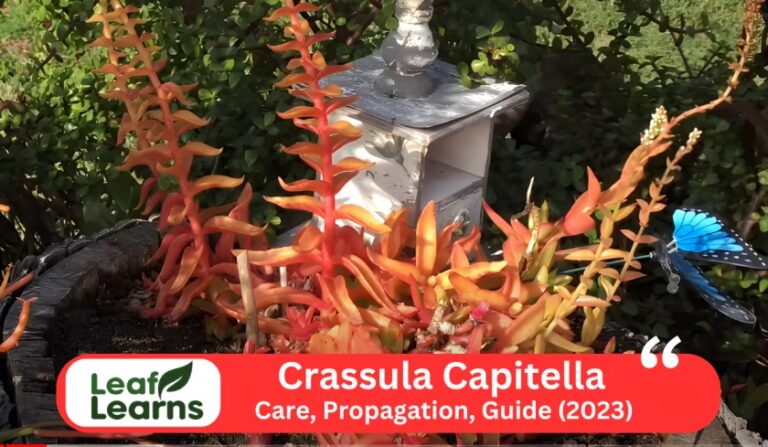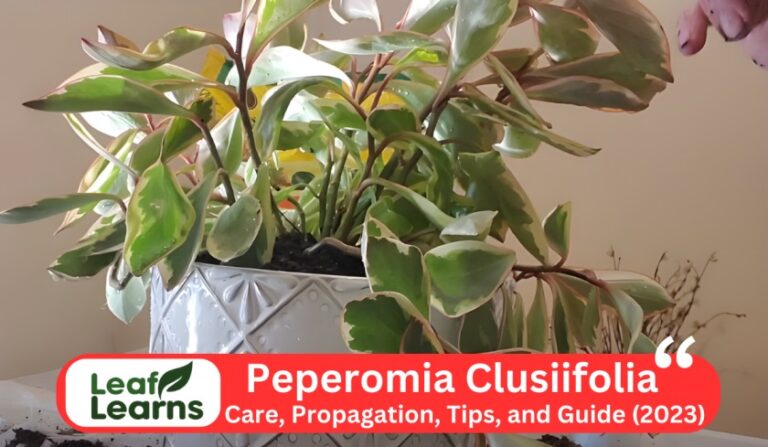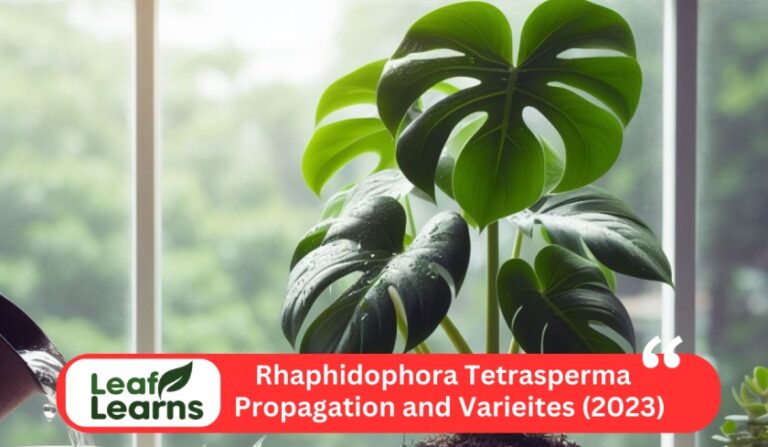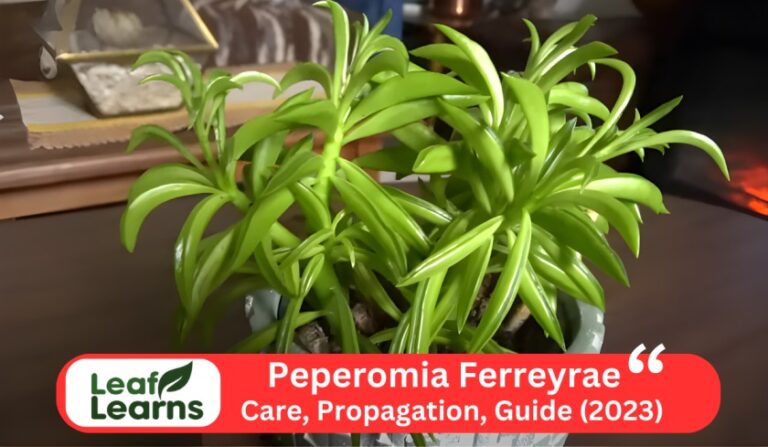Hoya pachyclada – Leaflearns (2024)
The Wax Plant is a striking and quite popular species from the tropical forests of the Philippines that belong to the genus Hoya pachyclada. It is of the Apocynaceae family, this beautiful plant has unique features that will make any indoor garden enriching. Hoya pachyclada is a Thai-based vine epiphyte. This plant is valued by collectors for its aesthetically pleasing and unique foliage and flower.
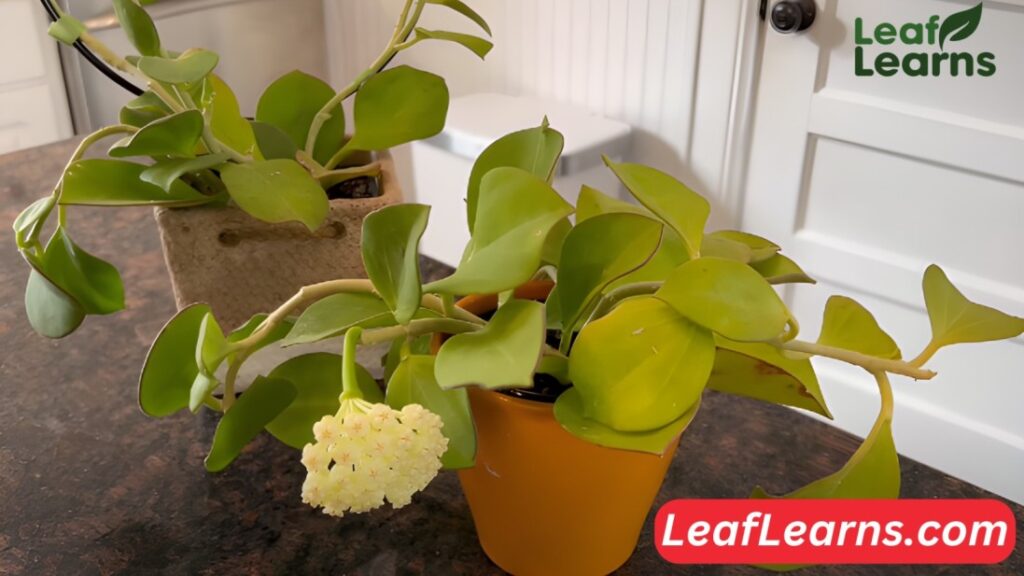
Unique features
They are dark green in colour and waxy in appearance. Star-shaped flowers: Hoya pachyclada has small flowers, star-shaped, and they are in clusters up to 30.
They are white or vivid yellow with a corona that may be light pink; they have a sweet lemony aroma.
Easy to care for: Hoya pachyclada is a moderately maintainable plant. It takes little water and fertilizer, and it has a great ability to withstand temperature and humidity level.
| Common Name | Wax plant |
| Scientific Name | Hoya pachyclada |
| Family | Apocynaceae |
| Origin | Philippines |
| Plant Type | Succulent Vine |
| Size | Up to 6 feet |
| Lifespan | Perennial |
| Leaf Colour | Green |
| Leaf Size | Small to medium |
| Flower | Small clusters of white or cream |
| Light | Bright indirect light |
| Water | Allow soil to dry between watering |
| Soil | Well-draining soil mix |
| Temperature | 18°C to 27°C (65°F to 80°F) |
| Humidity | Moderate to high humidity |
| USDA Zone | 10-11 |
| Fertilizer | Balanced liquid fertilizer monthly during growing season |
| Propagation | Stem cuttings |
| Pruning | Prune to control size and shape |
| Pests | Mealybugs, aphids |
| Toxicity | Non-toxic to humans and pets |
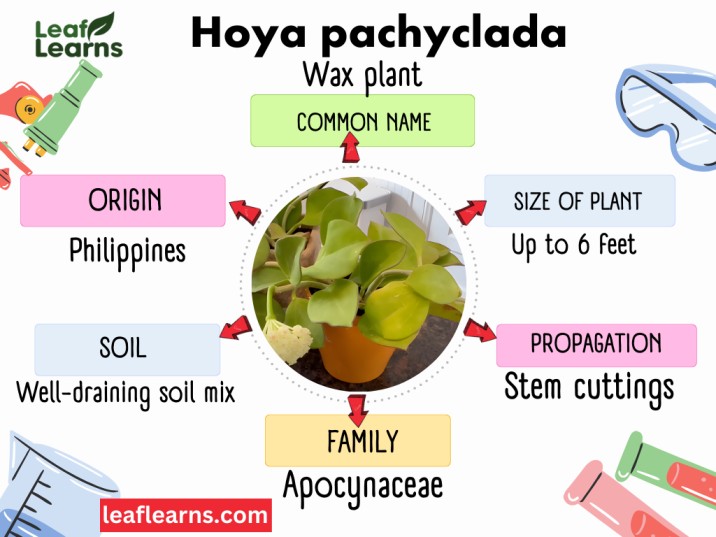
Contents
- 1 Hoya pachyclada Care
- 2 Hoya pachyclada Propagation
- 3 Pruning of Hoya pachyclada
- 4 Growth Rate and Size
- 5 Foliage
- 6 Hoya pachyclada Flower
- 7 Appearance and Fragrance
- 8 Is Hoya pachyclada rare
- 9 Fragrance
- 10 Common Pests and Diseases
- 11 Toxicity
- 12 Delving into the Diversity of Hoya-Pachyclada Varieties
- 13 Exploring the Intriguing World of Hoya Species
- 14 FAQs
Hoya pachyclada Care
Light Requirement
For best development wax plant, needs a certain amount of light that varies depending on the season.
Summertime: Envision soft sunshine filtering through a light tree canopy. An east or west facing window that provides midday shade is preferable, as the direct afternoon light can sear those priceless leaves.
Winter: Bright indirect light may not be sufficient as the days become shorter. To maintain your Hoya happy and flowering, think about adding a grow light and using it for four to six hours a day.
Spring: Gradually expose your Hoya to more direct morning sun as the days grow longer. This gradual increase of light will stimulate blossom buds and luxuriant development.
Autumn: As the days get shorter again, emulate the diffused light of summer.
Water Requirements
Watering this plant is “less is more” is ideal for its lush, waxy leaves and star-shaped blossoms. But it can be difficult to reach that perfect spot, particularly when the seasons change.
Summertime brings warm weather and wilting plants. Water your Hoya once a week, or whenever the top inch of soil seems dry. Steer clear of damp soil since it might cause root rot.
Winter: Your Hoya’s thirst decreases with colder temperatures and slower development. Before you water it once more, let the soil nearly totally dry out, around two to three inches down.
Spring: Increase the frequency of watering progressively as the days become longer and the growth accelerates. Aim to water no more than twice a week, or until the top inch of soil has dried.
Autumnal: As the days get shorter, follow the irrigation routine of summer. Allow the top inch of soil to dry before giving your Hoya another drink.
Soil Requirement
The Wax Plant needs well-draining soil all year round in order to thrive. Let’s investigate Hoya’s annual preferences for soil!
Summertime means breezy and light! A potting mix that drains well is essential. For ideal drainage, mix perlite or orchid bark with cactus soil.
Winter: The chance of soil compaction rises with decreasing temperatures. For even greater drainage and air circulation, add a little amount of perlite or pumice to your regular mixture.
Spring: Renewing your Hoya’s soil may be a good idea as new growth approaches. To guarantee that nutrients and oxygen reach the parched roots, replace the upper inch with a new, airy mixture.
Autumn: The secret is to recreate the soil of summer. As the days become shorter, stay true to your well-draining mix and resist the want to overwater.
Temperature Requirement
Hoya-pachyclada is a climate-adaptable plant that grows best in temperatures between 18°C and 27°C (65°F and 80°F).
Summer: Imagine the warmth of a tropical place without the intense light. The ideal temperature range is 70–85°F (21–29°C). Stay away from draughty areas and warm windows since too much heat will upset your Hoya.
A Winter Wonderland Keep your Hoya warm between 60 and 70°F (15 and 21°C) when the temperature drops. Keep your temperature above 50°F (10°C) to avoid damaging the foliage.
Spring Sprouts: As the days get warmer, progressively raise the temperature to the range of summer.
Autumnal: As the days get shorter, emulate the warmth of summer. When overnight drops become regularly chilly, move your Hoya to the winter range of 70–85°F (21–29°C).
Humidity Requirement
Hoyas pachyclada, with its star-shaped blossoms and thick, waxy leaves, is drawn to slightly damp air.
Think tropical feelings this summer! It is good to have a moderate humidity of 50–60%. You may increase humidity by grouping your Hoya with other plants or by using a pebble tray filled with water.
Winter: The air in your house dries out and warms up. In order to avoid leaf curling or falling, aim for a humidity of 40–50%.
Spring: The demand for humidity somewhat increases with new development. Increase the humidity gradually to 50–60% as the days become longer.
Autumnal: As the days become shorter, emulate the humidity of summer. Once regular nightly chills have been achieved, keep your Hoya at 50–60% and switch to winter’s range.
Fertilizer Requirement
The Wax Plant grows best when fertilizer treatments are balanced and adjusted for the plant’s seasonal requirements.
Less is more in the summertime! It is sufficient to apply a diluted amount of balanced liquid fertilizer once each month. Steer clear of overfeeding during warm weather as it might burn the roots.
Winter: Store the bag of fertilizer! Lower temperatures inhibit development, and feeding your Hoya at this period can do damage.
Spring: Start light feeding again as new growth is approaching. Once every six to eight weeks, fertilize by diluting your regular fertilizer solution even more.
Autumnal: Follow the eating pattern of the summer. Once a month, apply diluted fertilizer until nightly lows are routinely reached. After that, move to a winter water-only schedule.
Potting Requirement
But choosing the right pot and repotting schedule can be tricky, especially as seasons change.
Pot Choice
- Material: Choose clay or terracotta pots that allow plant air circulation. Particularly in the heat of summer, they wick away excess moisture, preventing root damage. You may use plastic pots as long as you have ones with drainage holes.
- Initial pot size should be somewhat bigger than the root ball. A pot that is too big will cause overwatering, while a pot that is too tiny can impede development. Repot your Hoya every two to three years as it reaches maturity; the pot should be 1-2 inches bigger.
Replacing Rhythm
Spring: As your Hoya awakens from its winter hibernation, now is the perfect moment to repot. Remove the Hoya from its container gently to check for rootbound plants. It’s time for a new home if roots are growing through drainage holes or around the container.
Summer: Avoid repotting in extreme heat, as it can stress the plant.
Autumn & Winter: Repotting during these seasons is not recommended. Cool temperatures and slower growth can make it harder for your Hoya to recover.
Hoya pachyclada Propagation
Here’s a detailed guide on how to propagate:
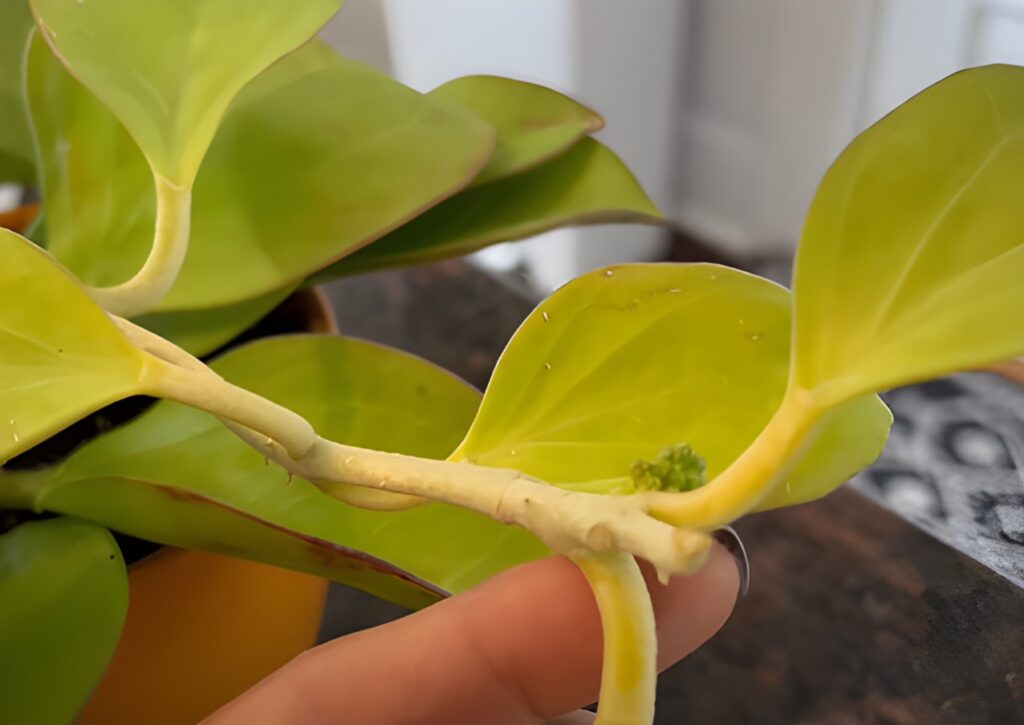
Choosing the Cutting: Take a healthy, at least two-noded stem from the parent plant. The places on the stem where leaves sprout are called nodes. Make sure there are no illnesses or injuries to the stem.
Cutting Ready: Make a clean cut slightly below a node using pruning shears or a clean, sharp knife. Verify that the cutting is around 4–6 inches. To reveal the nodes, remove any lower leaves that are close to the cut end.
Callousing the Cutting: Give the stem’s cut end a day or two to dry and callus. This keeps the cutting from decaying when it is planted.
Planting the Cutting: After the cutting end has become calloused, place it in a potting mix that drains properly. A combination of coarse sand, peat moss, and perlite can be used. Make sure that the earth covers at least one node.
Establishing Appropriate Conditions The pot should be placed in a warm, well-lit area with some indirect sunshine. Keep the cutting out of direct sunlight as it may burn it. Don’t overwater the soil; just a gentle misting is plenty.
Root Development: The buried node should start to produce roots a few weeks later. To check for root growth, you can gently tug on the incision to see if there is any resistance.
Transplanting: The cutting is ready to be moved into a larger pot with regular Hoya care once it has formed a strong root system, which normally takes 6 to 8 weeks.
Maintaining the New Plant: Give the new plant the same care and attention as you would an established, making sure it gets the right amount of light, water, and temperature.
Pruning of Hoya pachyclada
This plant requires routine trimming in order to keep its ideal size and form. To promote new growth, cut back any overgrown or lanky stems with clean, sharp scissors, being sure to cut just above a leaf node.
To improve the health and visual attractiveness of the plant, remove any dead or damaged leaves. Additionally, pruning encourages the growth of new flowers, keeping your plant rich and colourful all year round.
Repotting of Hoya pachyclada
To accommodate Hoya’s pachyclada expanding roots, choose a slightly bigger container with well-draining soil when repotting it. Repotting is usually necessary every 2-3 years or when the plant outgrows its pot. Gently take the plant out of its old container, work the roots loose, and then transfer it to the new pot, covering the base with fresh dirt.
Growth Rate and Size
With its star-shaped blossoms and thick, waxy leaves, Hoya pachyclada is a patient gardener. About 6 to 12 inches of growth may be anticipated this year, which makes it an excellent option for people who value a more methodical ascent.
Foliage
The combination of this plant leaves and blossoms is what really makes it a show-stopper, rather than merely its steady ascent. Clusters of thick, succulent leaves with complex veins and specks of silver embellish the rich green foliage of the vine.
Hoya pachyclada Flower
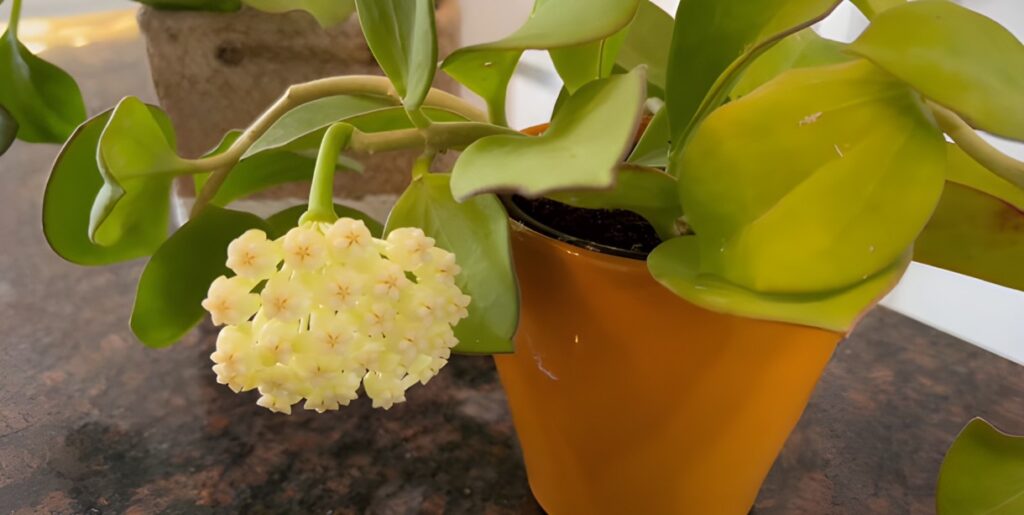
And lastly, the floral arrangements! Hoya-pachyclada rewards its carer with clusters of fragrant, star-shaped flowers when it is happy and mature. These fragile flowers appear in white or light pink hues, frequently with a corona of pink or yellow in the center.
Appearance and Fragrance
The rich, green foliage of Hoya-pachyclada, which is characterized by tiny to medium-sized leaves adorning its succulent vines, is captivating.
These leaves trailing along trellises or hung in hanging baskets provide a thick and eye-catching display. The plant stands out in any indoor garden or natural environment because to its compact growth habit, which also enhances its aesthetic appeal.
Is Hoya pachyclada rare
Although Hoya pachyclada is less frequent than certain other Hoya types, it is not regarded as exceptionally uncommon. Some internet merchants and specialist nurseries have it, however your neighbourhood large box store might not carry it.
Fragrance
Hoya-pachyclada captivates the senses with its dainty clusters of cream- or white-colored blooms that give off a delightful scent. These sporadic blossoms fill the air with their alluring aroma and lend a touch of natural elegance to any area.
Common Pests and Diseases
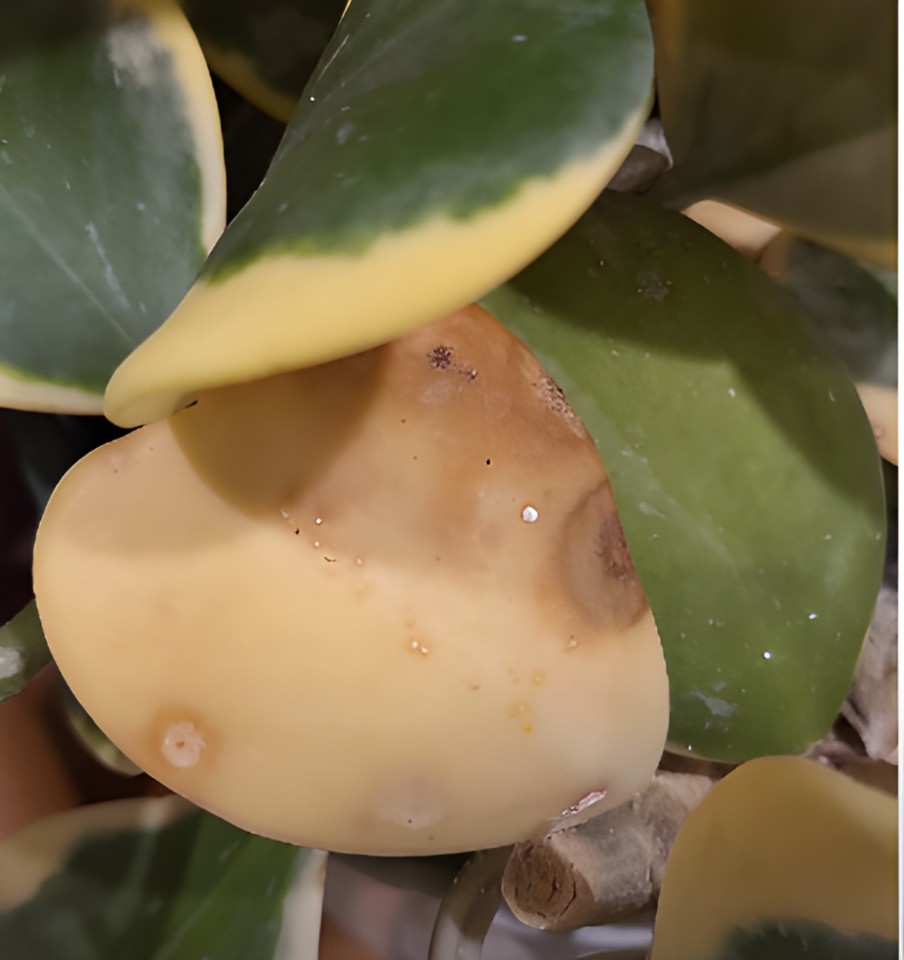
Mealybugs: These microscopic insects leave behind a white, cottony residue on leaves and stems after feeding on the sap of Hoya-pachyclada.
Aphids: Aphids are another prevalent pest that gather on the undersides of leaves, draining the plant’s fluids and disfiguring or turning the leaf yellow.
Scale Insects: These vermin cause little, raised lumps on stems and foliage where they adhere themselves. By removing the sap from the plant, they might weaken it.
Root Rot: This condition is brought on by excessive watering or improperly draining soil, which erodes the roots of the plant and eventually compromises its general health.
Leaf Spot: Fungal infections such as leaf spot, which are frequently brought on by an abundance of moisture or inadequate airflow, can appear as dark patches on leaves.
Toxicity
Hoya pachyclada is non-toxic to people, both interested adults and children can safely utilize it in their homes.
Enjoying its beautiful green leaves and occasional blossoms is worry-free because there are no known negative effects from handling or inadvertent intake.
For Dogs and Cats
Hoya pachyclada non toxic to Cats and Dogs. Because this plant is safe for both dogs and cats, cat owners who wish to add greenery to their homes without worrying about their pet’s safety can do so with peace of mind.
Delving into the Diversity of Hoya-Pachyclada Varieties
Hoya enthusiasts often find themselves drawn to the vast array of Hoya-Pachyclada varieties, each boasting unique characteristics and traits.
From the classic hoya-pachyclada to the variegated ‘new moon’ cultivar, these plants offer a delightful spectrum of colors and patterns, including white and red coronas, and variegated leaves.
Some enthusiasts may even seek out the more elusive specimens like the Hoya-Pachyclada gigantea or those with inner variegation.
With careful cultivation and attention, these plants can thrive indoors, adding a touch of natural beauty to any space. However, for those new to caring for these beauties, understanding their needs is paramount.

Exploring the Intriguing World of Hoya Species
Among the vast world of Hoya species and related plants, the Hoya-Pachyclada stands out as a particularly sought-after gem. However, it’s just one among many captivating species, including the dischidia, dasyantha, and padangensis.
Enthusiasts may also find intrigue in the unique traits of species like the Hoya parasitica with its black edge or the delicate blooms of the Hoya parviflora.
With each species comes a new opportunity for exploration and appreciation, whether it’s the variegated foliage of the hoya gracilis or the striking splashes of the hoya crassipetiolata. As hobbyists delve into the diverse world of Hoyas, they uncover a rich tapestry of botanical wonders, each with its own story to tell.
FAQs
How do you take care of Hoya Pachyclada?
Maintain moderate to high humidity levels, let the soil dry between waterings, and give Hoya Pachyclada strong indirect light.
Healthy development can also be encouraged by periodic pruning to manage size and form and by fertilising on a regular basis during the growing season.
What is the new name for Hoya Pachyclada?
There is no new official name for Hoya Pachyclada! Some vendors might use different trade names, but its scientific name remains Hoya Pachyclada.
Why is my Hoya Pachyclada not growing?
Hoya Pachyclada development may be inhibited by a number of conditions, such as inadequate light, excessive irrigation, poor soil drainage, low humidity, or a shortage of nutrients.
To promote healthy development, evaluate the plant’s surroundings and modify care procedures as necessary.

